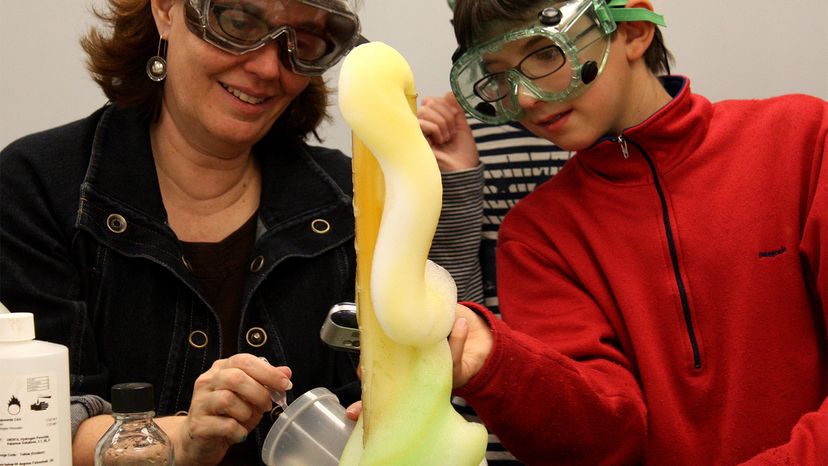“
As we all know, elephants probably don’t brush their teeth. But if they did, they probably wouldn’t use elephant toothpaste. It’s really fun to make, though.
Imagine shaving cream shooting out of a volcano you made for the science fair. That’s the satisfaction that comes with the foaming chemical reaction produced when you mix dish soap, hydrogen peroxide and dry yeast ― and the good news is, you can make it in your home. You know, if nobody minds you making a gigantic mess.
The elephant toothpaste reaction is just the speeding-up of a chemical reaction that usually happens very slowly. Hydrogen peroxide ― that antiseptic liquid that usually comes in a brown bottle and bubbles up when you put it on a cut ― is a chemical compound that’s made of two hydrogen and two oxygen molecules bonded together. The chemical formula for hydrogen peroxide is H2O2, which might sound a bit familiar because it’s very close to the most famous chemical compound of all time ― H2O, or plain old water. In fact, hydrogen peroxide, if left to its own devices, will sit around quietly decomposing into water and an extra oxygen atom ― especially when exposed to sunlight, which is why it comes in a dark brown bottle. But elephant toothpaste provides a way to see this chemical decomposition happen very quickly and dramatically.
The way to speed it up is to murder some yeast. These tiny organisms, like nearly all living things, contain an enzyme called catalase that acts as a catalyst for the reaction. Once the hydrogen peroxide comes in contact with the yeast, it starts splitting into water and oxygen gas at an alarming rate. The thing is, this reaction doesn’t look like much unless you add the third ingredient: dish soap.
Because the oxygen gas released by decomposing H2O2 just forms delicate bubbles that pop when they get to the surface, the spectacle of elephant toothpaste requires a little something extra to give the bubbles surface tension. Adding liquid soap preserves the bubbles and turns them into a rapidly proliferating foam.
Elephant Toothpaste Recipe
So, are you ready to make some elephant toothpaste? Great! You’ll need:
- 1/2 cup (4 fluid ounces, or 12 millilters) hydrogen peroxide. There are several different recipes online, but most agree that you get the best reaction with the 12 percent hydrogen peroxide solution (called "V40 developer") you can find at beauty supply stores ― the kind you use to bleach hair. That said, if you’re trying this with children, it might be safer (although less exciting) to use the 3 percent H2O2 you get in the brown bottle at the pharmacy, as the stronger stuff can really irritate skin and eyes. Of course, none of this stuff should be ingested.
- One packet of dry yeast granules you can find in the baking section of the grocery store.
- A giant dollop of dish soap.
- Food coloring, for flair, though this is optional.
- Warm water to activate the yeast.
- Protective eye gear like safety goggles or even your own eyeglasses. Gloves and an apron also would be a good idea.
- A container ― any bottle with a narrow neck will show off the elephant toothpaste reaction to its best advantage.
- A pan to catch your results, though a bathtub would be a smart place to do this experiment.
Follow the activation directions on the packet of yeast, adding warm water and waiting until it begins to fizz. Pour the hydrogen peroxide into the bottle first, adding a couple drops of food coloring if you wish, and a generous squirt of dish soap. Pour the yeast mixture in last, and watch it blast off!
Please don’t cap the bottle, and please don’t try to use this toothpaste on your own teeth!
Now That’s Interesting
If you like elephant toothpaste, you might really like the Mentos and Coke explosion.
Originally Published: Mar 18, 2020
Elephant Toothpaste FAQ
How do you make elephant toothpaste?
Elephant toothpaste is produced when you mix dish soap, hydrogen peroxide, and dry yeast.
Can you use 3 percent hydrogen peroxide for elephant toothpaste?
You get the best reaction with the 12 percent hydrogen peroxide solution, however, if you’re trying this with children, it might be safer to use the 3 percent hydrogen peroxide.
What is the meaning of elephant toothpaste?
Elephant toothpaste is the foaming chemical reaction produced when you mix dish soap, hydrogen peroxide, and dry yeast.
What kind of hydrogen peroxide do you need for elephant toothpaste?
If you want to get the most dramatic reaction, it’s recommended a 12 percent hydrogen peroxide solution, however, if you’re trying this with children, it might be safer to use the 3 percent hydrogen peroxide.
What causes elephant toothpaste to explode?
Yeast contains an enzyme called catalase that acts as a catalyst for the reaction in elephant toothpaste.